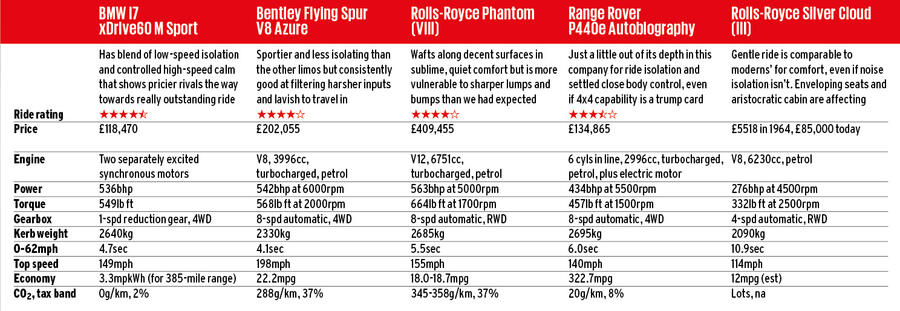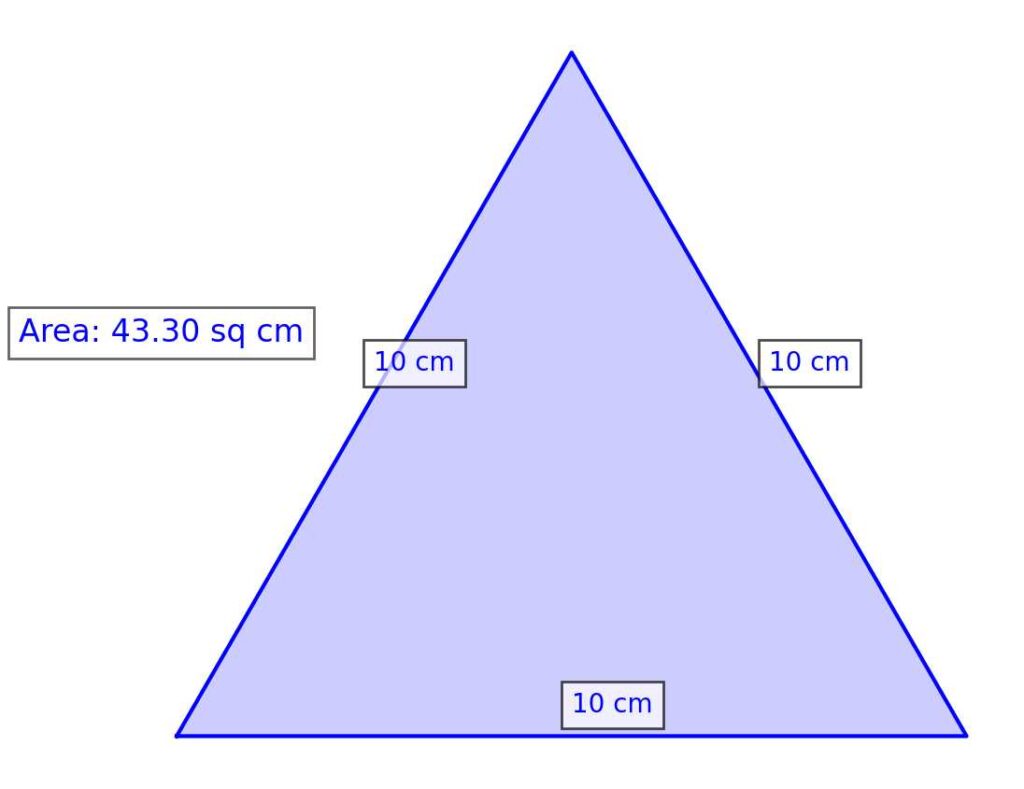The Brecon Hills were the ideal location to test the rides of these brutes We take to the road in five of the industry's smoothest operators to find out if ride comfort has regressed as a priority The area...
 The Brecon Hills were the ideal location to test the rides of these brutes
We take to the road in five of the industry's smoothest operators to find out if ride comfort has regressed as a priority
The Brecon Hills were the ideal location to test the rides of these brutes
We take to the road in five of the industry's smoothest operators to find out if ride comfort has regressed as a priority
The area formerly known as the Brecon Beacons was visited recently by the new Prince and Princess of Wales.
Apparently their cavalcade of luxury cars�wasn�t quite as impressive as ours, though. Standards matter � and if not the royal family, you can always depend on Autocar to set them.
Well, at least, as far as transport is concerned. If this comparison exercise had been an owners� club meeting instead, none of us assembled participants would have even approached the expected dress code requirements. Luckily, we had a job to do � and it was thanks to a reader whose name you will know.
Formula 1 racer turned motorsport magnate Jonathan Palmer consumes his weekly issue of Autocar as avidly as you do, and at a recent meeting with us he bemoaned the state of ride comfort in modern cars � that it hadn�t advanced as quickly as so many other dynamic facets.
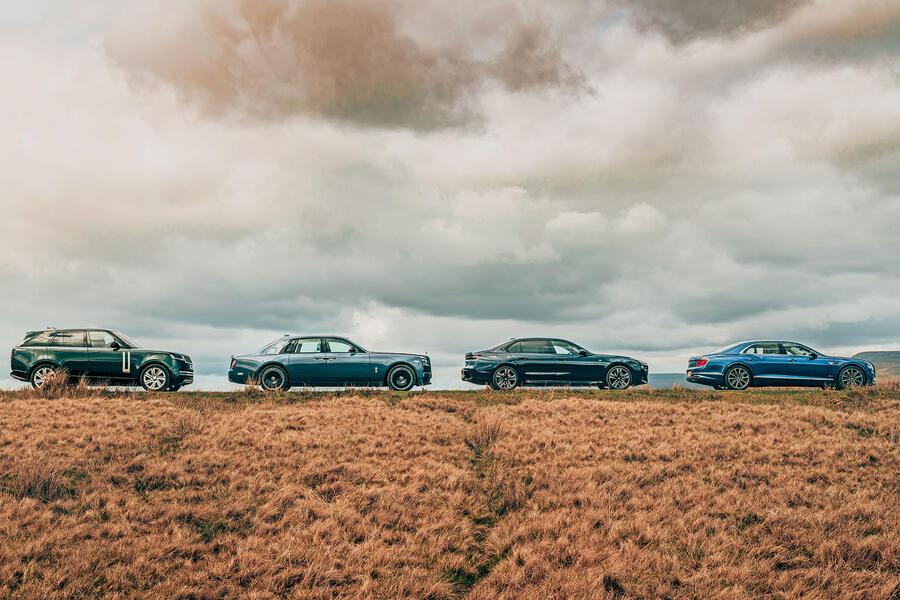
�Why don�t we get a bunch of the most comfortable and very best-riding new cars together, along with something much older,� he suggested, �and take a considered view�on the state of the art?�
How could we decline? The standard-bearers we assembled, in descending order of price, were the recently updated Rolls-Royce Phantom VIII, Bentley Flying Spur V8 Azure, Range Rover P440e Autobiography and BMW i7 xDrive60 M Sport.
Some 10 tonnes and nearly a million quid�s worth of brand-new, super-luxury metal, then (and we were still upstaged, as Dr P arrived in his no-doubt-fine-riding Agusta helicopter).
Another reader and friend of Autocar, Joe Ward, generously brought along his recently restored 1964 Rolls-Royce Silver Cloud III as a yardstick by which to measure the accomplishments of the new boys.
And, ride comfort being not only a complicated but also a subjective question, we decided not to tackle it on our own.
Providing an alternative and especially expert take was Steve Randle of Randle Engineering, a man with an impeccable CV in vehicle dynamics engineering on which the McLaren F1 can be found. Steve Cropley will be your guide to his thoughts and impressions of these cars, as well as those of Palmer, later on.
Quick links: Explaining ride comfort -�Rolls-Royce Silver Cloud - Rolls-Royce Phantom -�BMW i7 -�Bentley Flying Spur -�Range Rover -�Noise levels - Results - Final verdict�- Specs
How ride comfort is measured�
It feels a little odd to have a whole group test in which to zero in on one particular aspect of vehicle performance. I can�t think of a more interesting field of cars in which to do it, though � nor a more revealing blend of surfaces than those that rise, twist and wriggle their way over the eastern Brecon hills.
From cattle grids and crumbling verges to sunken gullies and sharp, blind crests, every kind of lump, bump and hollow that you need to form a full picture of�the isolation qualities of any chassis exists here.
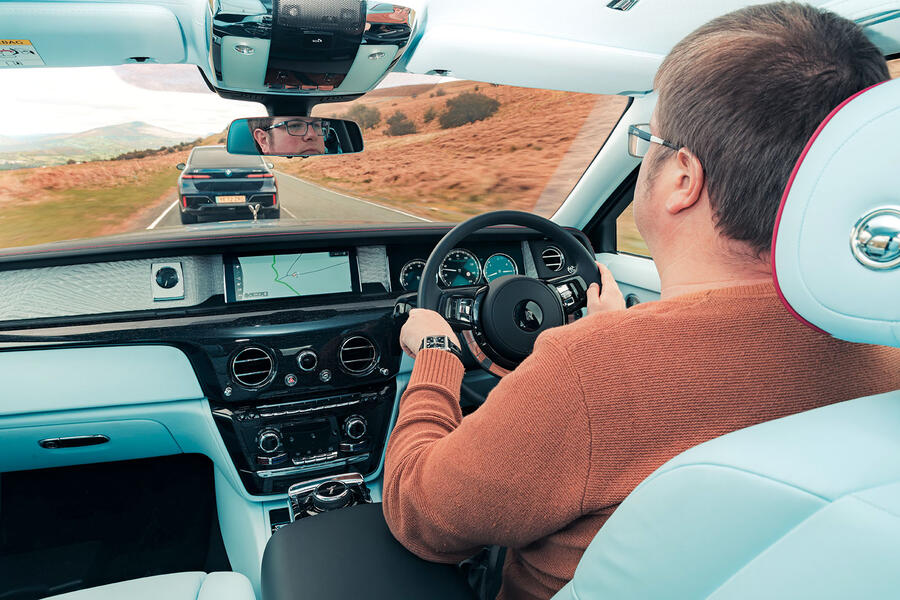
Much as I love to learn about this stuff, I�m quickly bamboozled when someone like Randle starts talking about longitudinal hub compliance, roll centre height, axle droop and the like. Ride quality is devilishly hard to anatomise � but nevertheless we can all tell a comfortable-riding car from its opposite.
We tend to break the subject down into primary and secondary ride. The first broadly concerns how much a car�s body pitches, rolls, heaves and bounces relative to the ground as it travels; the second how its wheels and axles move relative to its own body.
That�s to exclude the top-level comfort of a car�s seat and its driving position, though � which, when you really concentrate on it, can have a defining influence on ride comfort all by itself.
It also skates blithely over topics like surface-noise filtering, ride suppleness, body rigidity, damper response, close body control head toss and bump-thump isolation. (I haven�t made up any of these terms, I promise.)
Softness is as good a place to start as any. At the simplest of levels, soft-riding cars are comfortable ones, or so we�re encouraged to think. So which of these cars feel genuinely soft?
Rolls-Royce Silver Cloud�
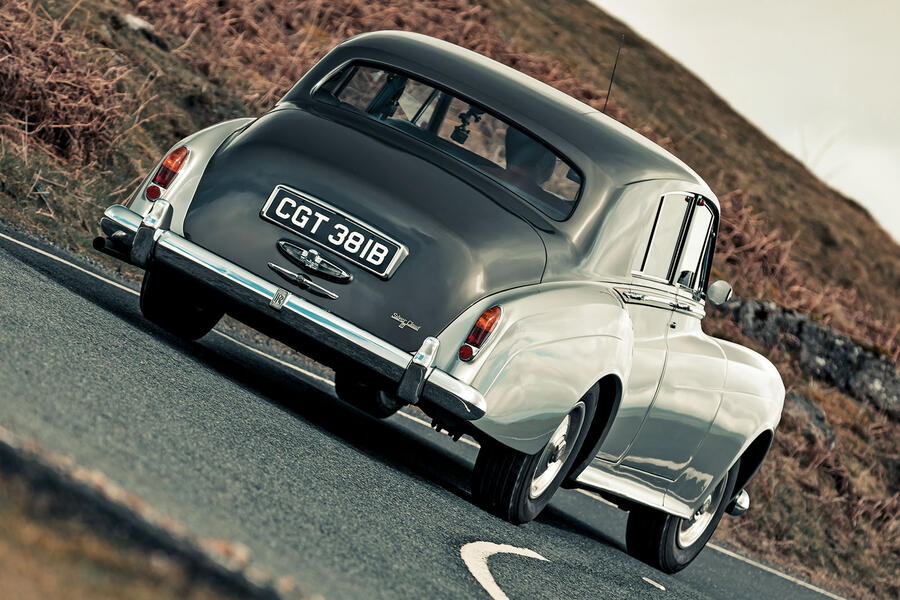
Only one, funnily enough: and it�s not the old one. On its 15in wheels and 75-aspect tyres,�I expected � perhaps wanted � the Silver Cloud to feel like the gentlest, waftiest car in our quintet.
But this quite clearly is a six-decades-old car on leaf springs and with a live rear axle. It rides softly, lacking only a little ride compliance and dexterity compared with the modern cars, but shows its age in every little twitter and creak of its gorgeous, graceful body and chassis.
Even so, it hovers, woofles and sweeps its way over a testing B-road so demurely, keeping its passengers comfortable, thanks in no small part to seat cushioning into which your backside disappears a little as if into a beanbag chair.
Rolls-Royce Phantom�
But it�s the Silver Cloud�s descendent, the Rolls-Royce Phantom, that really wafts � and, a little surprisingly, it�s the only modern limousine here to do it.
That�s a choice on Goodwood�s part. Rolls-Royce wants its flagship to feel more luxurious than anything else, so it has allowed it a softer-sprung, longer-travel ride gait than anything else in the modern super-luxury class. As we will come to later, it�s had to accept a few compromises as a result.
The bigger picture, as Rolls-Royce will see it, is that on the averagely well-surfaced roads over which any Phantom will travel for 99% of its life, it floats along in a way that feels almost supernatural. It glides over longer-wave inputs.
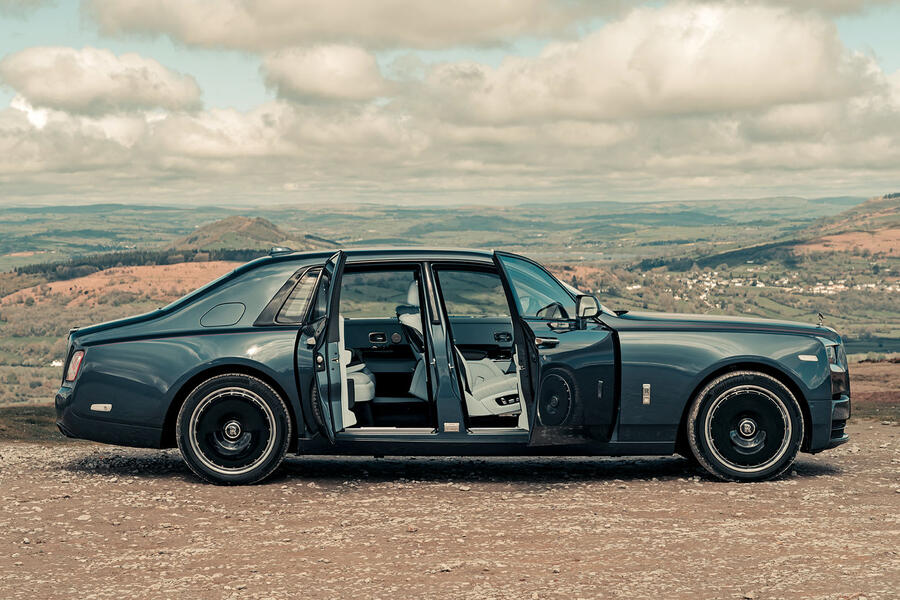
At just-so speeds it swells its way almost imperceptibly over crests and through compressions, taking the sting out of every little camber and gradient change. And, over the vast majority of roads, it�s little short of wonderful.
But it isn�t a perfect-riding car � not least because, as this exercise has handily reminded us, such a thing can not exist, no matter what it may cost.
The biggest surprise of our day was how clearly the Phantom�s ride could be exposed by sharper inputs.
The impact of these incidents is made to feel all the starker for two reasons: first because the Rolls-Royce�s ride is so good on smoother Tarmac that the sudden contrast inevitably seems harsh, and second because the Phantom�s pervading noise isolation is so good. It�s a bit of a victim of its own success.
At the same time, the sheer size and weight of the Phantom�s extruded-aluminium chassis becomes a factor. Physics dictates that making a body structure so large and long rigid � and therefore immune to body vibrations � is difficult.
So just occasionally, you can feel it momentarily shuddering ever so gently when the axles are working especially hard.
Well, well � there�s a turn-up for the books. We should remember, of course, that we had to go looking for road surfaces tough enough to punish and expose the big Roller in order to learn that about it, and only could we do it after back-to-back driving in the company of some of the most comfortable rivals we could think to pitch it against.
BMW i7�
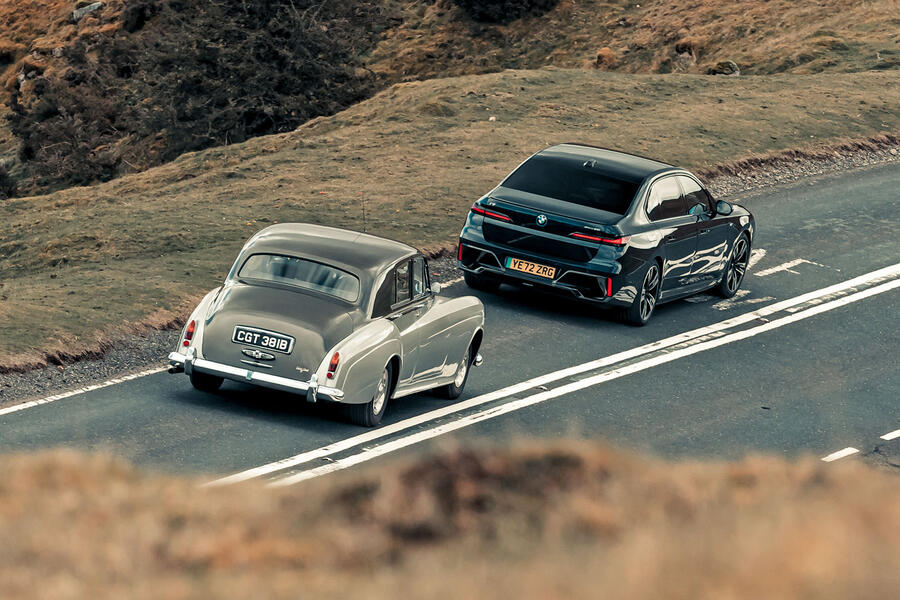
For that soft-and-wafty feel, next in line is the electric BMW i7. The BMW�s sense of ultra-low, parking-speed plushness is actually better than any other car�s here.
It begins to feel a little firmer, more reactive to the road surface beneath it and more typically BMW as speeds rise. But even so, its overall ride comfort is very impressive indeed.�
Bentley Flying Spur�
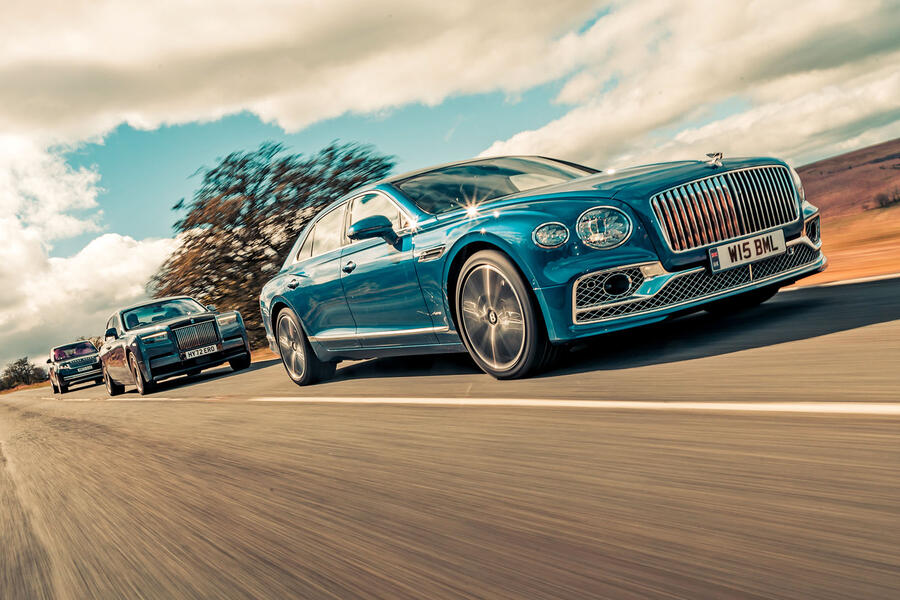
Finally comes the Bentley Flying Spur. Few passengers could ride in one in isolation and consider it to be a firm-riding car, surely, but it undeniably has a firmer secondary ride and a closer connection�to the road surface than any of its rivals.
Just like the Phantom, it�s that way by choice, not as a result of any deficiency. Even in the comfort-oriented Azure trim level (which adds special seat upholsteries and cabin materials, plus a �curated� equipment specification), the Bentley wants to put you in touch with the road, if only just enough so you can feel how much it�s making the suspension work.
That way, you�re involved with what you�re doing, and the car is ready to go as quickly or slowly as you may be inclined to drive it.
These are, at a fundamental level, just different takes on how luxury can be manifested � can feel � in a modern car. Lavish, ostentatious and genteel; technologically bold and avant-garde; or less formal and more obliging and adaptable, although no less traditional.
What�s especially interesting, however, is what happens when the road surface you�re travelling over deteriorates. This is when a car�s ability to keep its body movements in check over asymmetrical inputs becomes a factor, for instance.

Or to retain some wheel travel in reserve when it�s cornering, in order to absorb a mid-bend bump. To round the edges off sharper intrusions and bits of raised ironwork � allowing enough wheel travel to do so without letting those wheels travel too quickly or too far, to thump harshly into their bump stops.�
This is where the ride engineer�s painstaking attention to detail really shows. So which limousine�s mask slips farthest over rougher roads?
Not the Bentley�s, that�s for sure. You might call this the most honest, consistent-riding car of our modern quartet, because while it has that distantly pattering secondary ride, it also has the damping authority to soften, filter and massage away bigger, sharper inputs better than most.
It maintains a relaxed but semi-taut kind of body control that breathes with the road but isn�t stretched or punctured by it. And so it does damned near as good a job of riding pleasantly at a quicker pace, on tougher roads, as it does at gentle pace on less testing ones. It�s dynamically versatile.
Range Rover�

The same can�t quite be said for the Range Rover, whose elevated driving position and great ergonomics certainly make you comfortable at the wheel but whose relatively permissive body control and slightly patchy axle isolation make it ride in more excitable fashion than the best of the rest.�
There just feels like there�s a bit too much of the car for the axles to manage at times and that the greater distance there is between its tyres and passengers isn�t being capitalised on quite as successfully as it might be.
Noise levels�
I took our road test decibel meter to all five cars, measuring in-cabin ambient noise at a 50mph cross-country cruise in the back seats. Limo pace, in other words.
The results � Silver Cloud 67dBA, Range Rover 60dBA, i7 59dBA, Flying Spur 58dBA and Phantom 54dBA � speak resoundingly for themselves.
The Phantom is an exceptionally quiet-riding car � except when it clunks over a shallow pothole or an expansion joint, when its suspension struts can thwack into their bump stops with borderline rudeness.
That�s the inevitable result of the car�s waftily permissive suspension tuning and relaxed wheel control.
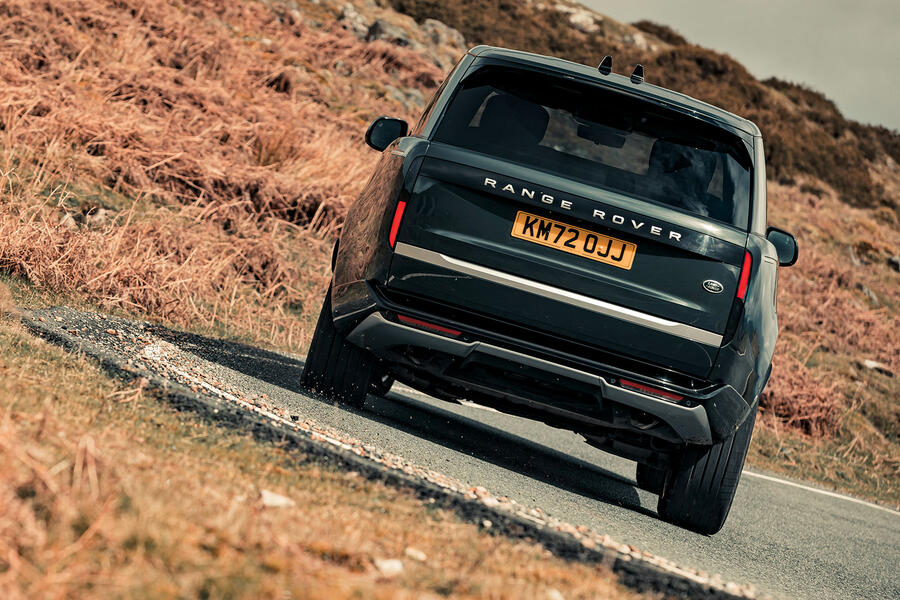
Ultimately, though, all of these cars bear witness to the fact that ride tuning remains a question of specific compromise � even in 2023, and even with a sky-is-the-limit engineering budget at your disposal.
Every player in the segment defines their own take differently. Every manufacturer could no doubt find data to back up the effectiveness of their own execution and tuning, if given the chance.
But clearly even those operating with all the advantages can be guilty of an oversight or two.
Results�

As if to prove the point, at the end of our exercise, the car whose ride comfort stood out for the most consistent praise wasn�t the ostentatious, hyper-expensive Rolls-Royce or the members� club Bentley � it was the cheapest one we had.
In addition to its pillowy-soft low-speed feel, the i7�s ability to maintain a level and settled body, to keep its passengers in their soft, well-shaped seats, to resist head toss when dealing with drains and crowned roads and to soak up the punishment dished out by sharper intrusions as well as gentler ones made it the only limousine here not to have at least one blot on its report card.
Palmer was happier in this better-shaped rear seat but a bit surprised that the Bentley�was beaten on several points of refinement by a half-price BMW.
Randle, meanwhile, was impressed by the cohesive character of the Flying Spur. �The damping is very good,� he observed, �but the isolation doesn�t match the BMW�s.�
The Rolls-Royce was expected to wipe the floor with the others, but didn�t. It was good in its low-rate way, but these narrow, pocked, up-and-down roads weren�t its metier and tested its wheel control.

Randle was surprised by a low-speed rumble, while Palmer was unimpressed by the fact that the wheels � estimated at a hefty 30kg each � reached the end of their travel several times. There were occasional aftershocks through the mammoth aluminium spaceframe body, too.
In this company, our experts felt that the Range Rover was outclassed. Palmer reckoned the up-and-down nature of our route drew attention to the innate drawbacks of an SUV, the sideways body movement (despite active roll control) and a degree of longitudinal nose dive and squat. He had expected it to eclipse the Bentley and so was disappointed. Randle concurred but was a bit more understanding of its built-in disadvantages.
Still, he would have preferred the relaxed, strolling gait of past top-end Land Rover products, notably the Land Rover Discovery 4, which doesn�t have a sporty bone in its body.
It was no surprise that the Silver Cloud wasn�t a serious competitor for this lot, which after all together set the class standard. But it stressed two things: old-time elegance that exceeded any of the others and the fact that the gap between top-end cars 60 years ago and now isn�t as great as you might think.
Conclusions were varied and complex, but two things stood out. Talking about ride comfort, there�s still a powerful case for saloons over SUVs. The Range Rover may be king for versatility, but it isn�t for ride comfort.
The same goes for the Rolls-Royce. Where it�s intended to be great, it�s unparalleled, but difficult roads like these abound in the UK. It did well but not best.
Final verdict�
The tussle, our experts felt, was between the BMW and the Bentley.
For all his lifelong involvement with pure performance, Palmer is a true lover of very high-level refinement, and that turned him towards the BMW. Randle appreciated all this but best liked the Bentley, because its designers� chosen persona was reflected in everything that it did.
Perhaps the biggest lesson � and music to a product reviewer�s ears � is that there�s still�no perfection.
As our sartorially inelegant band of road testers, experts and enthusiasts had it one day in April in the newly christened Bannau Brycheiniog, then, the nearest thing to the perfect-riding car you can buy in 2023 � and indeed the closest to a helicopter ride home � is an electric BMW.�
Specs�
